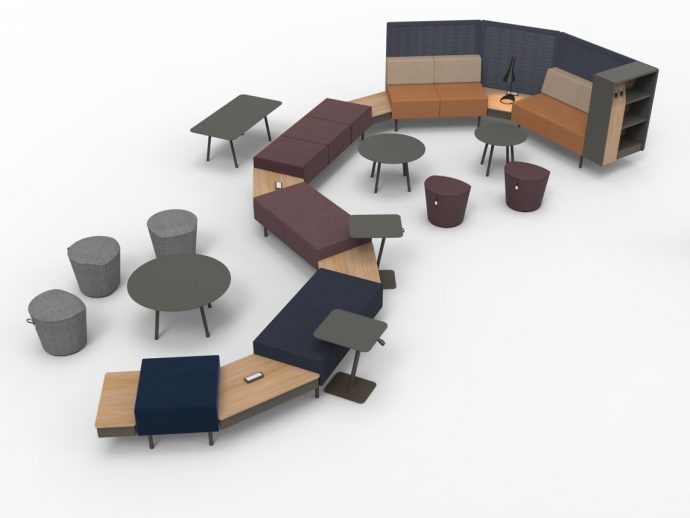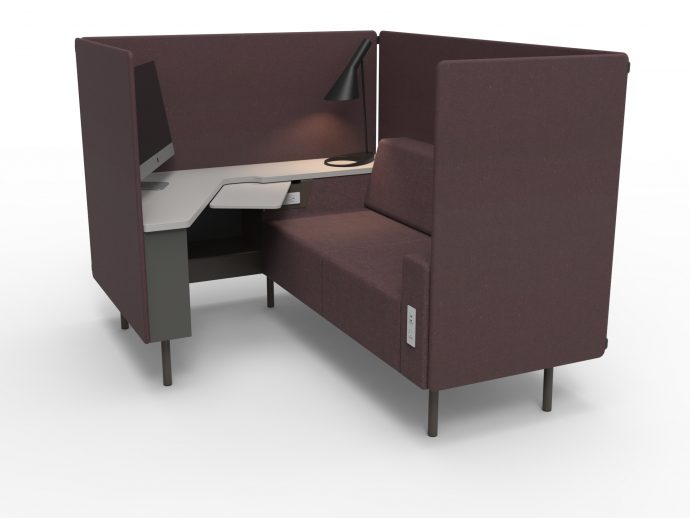Allseating’s Exchange can be configured over 2,725 ways – how’d they do that?

Allseating presents an expanded offering of its modular soft seating, Exchange for this year’s NeoCon. Comprised of just seven injection-molded plastic components and a series of support rails, the product can now be specified in virtually unlimited configurations, building on the 2,725 standard variations that were possible with the first iteration of Exchange.
Recognizing the increasing need for flexibility and demand for furniture options that can be easily relocated and reconfigured, Exchange’s versatile two-foot module can support a span of nine feet between legs. This construction allows a light aesthetic while providing versatile, comfortable seating options for spaces ranging from reception to cafeteria. Multiple arm configurations, a comprehensive privacy screen program and capability to add power options add to the flexibility of Exchange.
“We have taken note of the evolving needs of the office as the walls continue to come down. More open, collaborative settings require an accessible solution that can be easily reconfigured as needs change. As companies move to more activity-based work-styles, the furniture requirements are changing as well.” – Nick Gillissie
Who designed this product?
Designed by Nick Gillissie in collaboration with Allseating.

What was the inspiration behind the design?
It started with research into the current soft seating landscape in the contract furniture industry. The space we identified in which Allseating could offer something new and unique that supports emerging work trends was a soft seating system versatile enough to be configured for use in waiting areas, relaxation spaces, social areas, collaborative group settings and individual focus applications.

What innovations in the choice of materials or fabrication are utilized in the manufacture of Exchange?
Exchange is a modular soft seating system that is manufactured using seven injection molded plastic parts, instead of plywood boxes. By using long span steel supports, Exchange’s clean lines are not interrupted by the visual clutter of multiple legs and feet required to support most modular seating systems on the market. Exchange’s plastic molded interior also offers an environmental story, as the core is made partially from recycled materials.
Where do you think the installation of this product will be most useful?
Exchange was designed with the corporate office, and higher education uses in mind. We wanted to produce comfortable soft seating that included options for power access and privacy, that also was flexible enough to support the needs of an activity-based work environment. We felt that the product had to work for people in all work postures.
We are currently adding pieces and configuring the product to support the needs of healthcare environments. There are some exciting possibilities in this area as well.
A year from now what would be the most exciting thing you could think of that would find out about how the product has been accepted, specified and installed in projects?
We love hearing stories about how our products are used. There are some things we would like to hear, but one thing that we think is going to happen is how an installation was changed as the end user’s work needs evolved. Perhaps it will be about how a client bought the product configured for one anticipated use, but then experienced an unexpected change, such as a move or a significant headcount increase. The product they specified then didn’t suit the new requirements, but by how Exchange is made and configured, they were to be able to reconfigure the pieces they purchased into new layouts to meet their unique needs. We have designed Exchange to evolve as business needs change and to be an investment in flexible furnishings, not a single-use product.

How will the product impact workplace design?
Less structured ways of working require a variety of spaces to support both heads-down and more open collaborative spaces. These settings go beyond the norms of a task chair at a desk, or a table surrounded by conference chairs in an enclosed room. Exchange offers opportunities to change up how and where people sit to either work on their own or in groups. The reconfigurable aspect supports the movement to the newer ways people are choosing to work across an entire work environment rather than the more traditional, sedentary workplace design of the assigned seat, one place, all day! Exchange was designed to be a modular solution that emphasizes comfort and supports functionality.
Does the product contribute to new ways of working?
When introduced, the focus of Exchange was meeting the needs of today’s knowledge workers across the varied contexts of the corporate floor plate. The system can make a lovely club chair or couch for the reception area, but it can also create long linear benches, banquettes, and open plan collaborative settings. It can feature surrounding screens to create a sense of enclosure. It has a variety of power options and can be specified with wide arms at keyboarding height to support mobile tech.
All these features are geared towards versatility and convenience to meet the needs of the moment.
This year, we put our put our minds to achieving some of the longer-term needs of individuals operating within nontraditional work environments, such as no-fixed address and agile offices.
- Where can I sit for 15 minutes while I wait for my meeting?
- Where do I sit when everybody is in the office, and there are no free workstations?
- How long can I work on this couch…an hour…two hours?
- Does it have a good surface for typing?
- Where do I put my: knapsack, briefcase, helmet, purse, umbrella, jacket…while I work?
- I need to have a more involved meeting with a TV, screen sharing, and a writing surface, but all the meeting rooms are booked…
Our latest additions to the Exchange line, being previewed at NeoCon this year, build on the idea of creating a destination within a workplace; everything the user needs for their daily tasks is accessible within Exchange: storage, power, privacy, laptop tables, tablets, for example.
These functional additions, along with many beautiful additions, take the second iteration of Exchange from addressing the needs of the moment to addressing the needs of the user’s full day.
Some of the enhancements include:
- Armrests with storage for personal items.
- Larger storage units for with shelving and hooks for coats and bags.
- Small tables at heights suited towards the use of laptops and tablets for non-assigned workspaces.
- Extended armrests with larger surface areas to support extended periods of work
- Higher screen options with sound absorbing qualities for to mitigate noise from within collaborative settings.
- Mesh screens for a lighter aesthetic while maintaining a sense of privacy.
- Linked storage units for the storage of collaborative technology and support of screens and whiteboards for the creation and sharing of visuals.
- 120-degree planning capabilities that make it easier to create larger and longer seating configurations that fit into more spaces and can be used for a wider variety of lone working and gathering needs.
- New aesthetic variations such as wood, bent wire, and polished flat bar legs.
Can you give an example of how this product can effectively be used in a project?
We can see Exchange used in projects where the designer wants visual continuity between all soft seating applications across the entire floor plan, and the facility manager wants to simplify the inventory with products requiring as few replacement parts as possible. With Exchange, all seat, back, and leg components can be uniform throughout the facility. Arm styles can be changed out based on space use. Wide, low arms with Power/USB can be located as needed in collaborative areas to support laptop use. More formal spaces can be defined with narrow, high arms for a more formal “club chair” look. Again, power can be provided so visitors can charge devices while waiting for appointments. Privacy screens can be installed on sofas to create banquette seating in the cafeteria area. For large-scale meeting spaces, Exchange can be configured to meet a more custom layout to suit the space. No matter the configuration, all are comprised of the same seven molded plastic components – making for ease of specification, simplified inventory and easy re-configuration.

When will the product be available for specification?
Exchange is available as of June 2018, while the second iteration of Exchange, including over 15 new options, will be available in 2019.
What do you think our readers will love about the product?
Over 2,725 possible modular configurations provide endless creativity and cohesion for the entire floor plan at an accessible price point. We hope your readers get to the Allseating showroom at Neocon, across the street from the Mart at 325 N Wells unit 210, so that they can see and test Exchange in person. We have found that once people sit in Exchange, they are unexpectedly delighted. The combination of soft and firm components makes it extraordinarily comfortable yet supportive, and the overall design aesthetic supports collaboration, working alone or kicking back to relax.
What can you tell us about the pricing?
A single unit of Exchange, the club chair, starts at a base list price of $1150 without arms. From here, over 2725 different configurations can be created from various options, including Single, Double, Triple and Quad sofas, L-shaped and U-shaped configurations, as well as custom layouts. Four arm options, power/USB, five table and tablet options, three privacy screen sizes, 13 laminates and 16 paint colors are available to customize Exchange to the needs of the user.
Where can we find you at Neocon?
Exchange part two will be previewed at NeoCon 2018, in the Allseating showroom, located across the street from the mart at 325 N Wells Unit 210.


